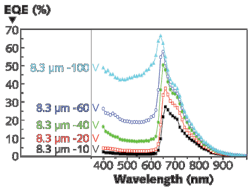A polymer photodetector with a photoresponse that is voltage-adjustable from the visible to the near-IR range has been created by researchers at the National Tsing Hua University and the National Chiao Tung University (both in Hsinchu, Taiwan). The detectors were made of a blend of so-called P3HT and PCBM polymers; the researchers fabricated devices with many different thicknesses ranging from 250 nm to 16.2 µm, and found that a detector with a thickness of 8.3 µm worked best.
The spectral response of the photodetector to light between 400 and 100 nm was monitored as the reverse bias on the device was varied between -10 to -100 V. Whereas for a bias of -10 V the external quantum efficiency (EQE) of the detector was uniformly high across the visible spectrum, at a bias of -100 V the visible EQE dropped to zero while the near-IR EQE remained high (although dropping slightly). The square-wave transient response at 20 Hz was square but at 10 kHz became approximately triangular. Such photodetectors could be fabricated in large-area arrays, allowing fast switching from visible to near-IR imaging. Contact Hsin-Fei Meng at [email protected].
More Laser Focus World Current Issue Articles
More Laser Focus World Archives Issue Articles
